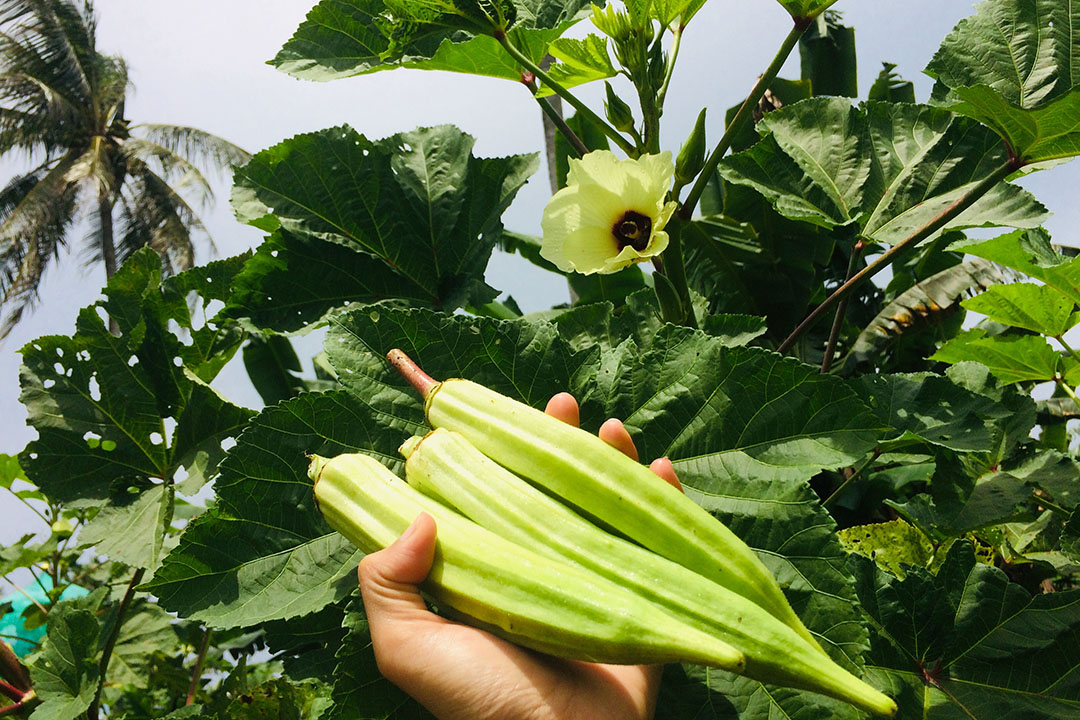Okra fruit: Enhancing broiler meat quality

A phytogenic additive – ’Okra fruit’ – has been shown to improve the meat quality of broilers. Eating this fruit also improves the bird’s health status as it possesses, among other characteristics, antibacterial, anthelmintic, and antioxidant properties.
Okra (Abelmoschus esculentus), also known as lady’s finger or ochro, is an economically important vegetable crop that is commonly grown in tropical and sub-tropical areas of the world. It is mainly cultivated for its seeds and fruits. Its cultivation is relatively easy compared to most vegetables, as it can grow in a variety of soil types. Researchers at the Zagazig University have recently published an interesting finding on the positive impacts of dried okra fruit powder on growth, immunity, carcass, and the meat quality of broilers. Their study consisted of the following diets:
- Control (basal feed);
- 3 diets with okra fruit at 3 different inclusion levels (1 g/kg feed; 2 g/kg feed; 3 g/kg feed). Chicks were given the feed in mashed form, from 1 to 5 weeks of age.
Carcass yield and quality
What the researchers observed is that the carcass weight was similar regardless of the diet. However, feeding birds with 2 g okra fruit/kg feed resulted in the best breast meat yield. Birds feeding on okra supplemented diets had 13% less abdominal fat than control, measured at 5 weeks of age. They attributed these results to the antioxidant property of the okra; antioxidants reduce the activity of cytosolic malic enzyme, leading to suppressed abdominal fat deposition. Meat colour is an important assessment criterion and is one of the most important factors influencing consumers’ acceptance of meat and meat products.
Undesirable changes in colour parameters and sensory properties of meat during storage are caused by the compounds produced during oxidative degradation of lipids and a decrease in water-holding capacity. The decrease in colour intensity and water holding capacity following 3-month storage was lowest for the maximum inclusion (3 g/kg) of okra fruit. In addition, the microbiological quality of the meat was assessed for total bacterial, psychrophilic bacterial, and yeast and mould counts. As could be observed in the control diet, meat samples treated with different okra levels showed a gradual increase in total bacterial counts over time; however, the rate of increase was remarkably lower than that observed in the control sample.

Oxidative rancidity
The major factor affecting meat sensory characteristics is lipid oxidation during storage. The TBA test (Thiobarbituric acid reactive substances assay), one of the most widely used methods for measuring the oxidative rancidity of food, was used. As expected, there was an increase in the TBA value in all the samples during freezing storage (measured up to 3 months). However, oxidative rancidity was far less in broiler meat supplemented with okra than in untreated control samples, throughout the storage period. These researchers pointed to the presence of total phenolics and flavonoids in okra fruit that have an antioxidant effect. In addition, okra fruit is rich in vitamin E and carotenoids – providing an additional shield against oxidative stress, thus offering a key role in the stability and shelf life of the meat.
 Bird growth boosted through nano minerals in poultry feed
Bird growth boosted through nano minerals in poultry feed
Researchers are claiming that nano minerals in poultry feed can improve broiler growth as well as boosting feed consumption and digestibility.
Improved immunity and growth
Okra fruit supplementation was found to enhance the immune system of broilers. This was observed through significantly higher lysozymes and Immunoglobulin M (IgM) values in groups supplemented with okra than in the control group (see Table 1). A clear improvement in the growth rate of chicks supplemented with okra fruit was observed with the 3 g/kg inclusion rate. It was suggested that this improved growth might be due to the bioactive components which enhance the utilisation and efficiency of feed; bioactive components cause alterations in the permeation characteristics and membrane dynamics and in the protein synthesis associated with cytoskeletal function, which increases the absorptive surface area of the small intestine.
On the other hand, the effects of okra supplementation on FCR were not significant. However, diets supplemented with okra fruit at the level of 1 g/kg feed resulted in a better FCR, both during the second (3-5 weeks) and the entire experimental period (1-5 weeks). It was also suggested that phytogenic additives may enhance the bird’s feed intake, stimulate the secretion of digestive enzymes and the conversion of feed; however, the mode of action is not clear. The feed intake was highest in chicks fed okra fruit at 1 g/kg feed, while the lowest intake was recorded in the control diet.
Okra or synthetic pigments?
Pigmentation is also an important factor in consumer acceptance and perception of broiler meat quality in many countries. In a similar study, the use of natural (okra) and synthetic pigments in broiler diets was evaluated. Pigmentation of the chicken skin and abdominal fat were significantly improved in the 4 and 5% okra inclusion levels. The pigmentation effect reached a satisfactory level after 4 weeks of treatment. It was concluded that the xanthophyll-rich okra meal can be used as a natural pigment source in poultry feed, thus reducing feed costs associated with expensive synthetic pigments.
 Benefits of broccoli for broilers
Benefits of broccoli for broilers
The feed industry is constantly seeking sustainable alternatives to antibiotics. Broccoli residues have valuable antimicrobial and antioxidant properties that make them an attractive alternative.
In conclusion, at appropriate inclusion levels, okra fruit can be used as a natural supplement in broiler diets for improving meat quality, growth performance and the immune system. In addition, it is a safe and cheap way to improve the technological and sensory qualities of stored chicken meat products. Furthermore, its richness in pigments offers an affordable source of natural pigment in poultry feed.











